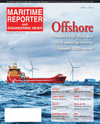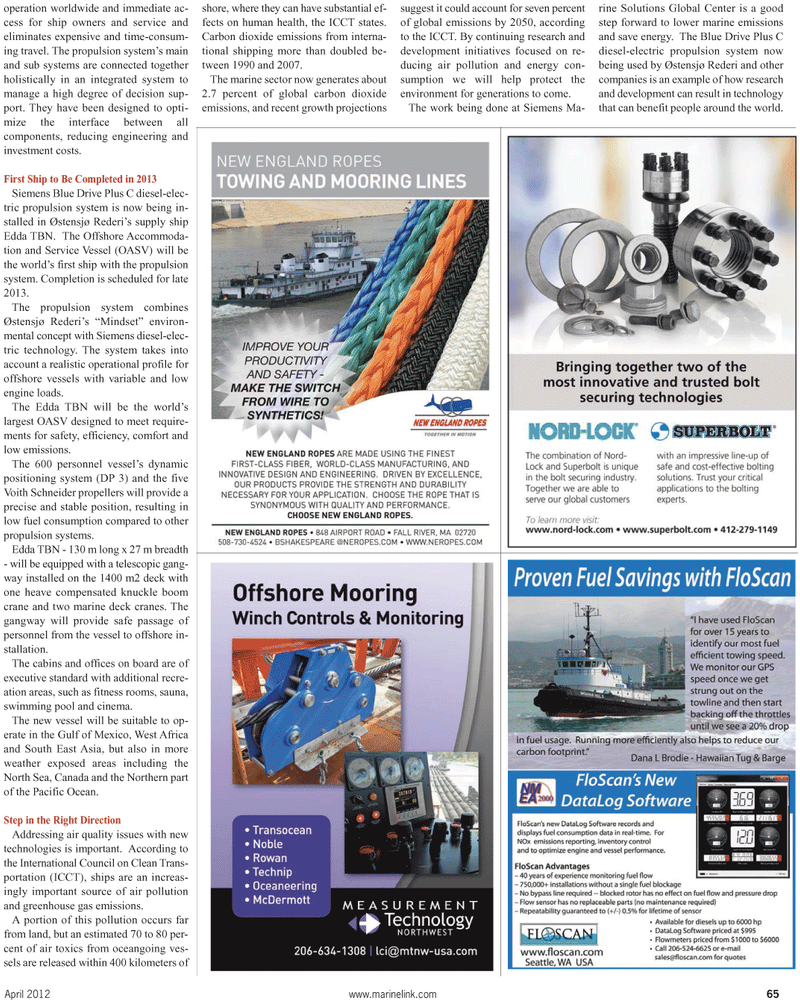
Page 69: of Maritime Reporter Magazine (April 2012)
Offshore Deepwater Annual
Read this page in Pdf, Flash or Html5 edition of April 2012 Maritime Reporter Magazine
operation worldwide and immediate ac- cess for ship owners and service and eliminates expensive and time-consum- ing travel. The propulsion systems main and sub systems are connected togetherholistically in an integrated system to manage a high degree of decision sup- port. They have been designed to opti- mize the interface between all components, reducing engineering andinvestment costs. First Ship to Be Completed in 2013Siemens Blue Drive Plus C diesel-elec- tric propulsion system is now being in- stalled in Østensjø Rederis supply ship Edda TBN. The Offshore Accommoda- tion and Service Vessel (OASV) will be the worlds first ship with the propulsion system. Completion is scheduled for late2013.The propulsion system combinesØstensjø Rederis Mindset? environ- mental concept with Siemens diesel-elec-tric technology. The system takes into account a realistic operational profile for offshore vessels with variable and low engine loads.The Edda TBN will be the worlds largest OASV designed to meet require- ments for safety, efficiency, comfort and low emissions. The 600 personnel vessels dynamic positioning system (DP 3) and the five Voith Schneider propellers will provide a precise and stable position, resulting inlow fuel consumption compared to other propulsion systems.Edda TBN - 130 m long x 27 m breadth - will be equipped with a telescopic gang- way installed on the 1400 m2 deck with one heave compensated knuckle boom crane and two marine deck cranes. The gangway will provide safe passage of personnel from the vessel to offshore in- stallation.The cabins and offices on board are of executive standard with additional recre- ation areas, such as fitness rooms, sauna, swimming pool and cinema. The new vessel will be suitable to op- erate in the Gulf of Mexico, West Africa and South East Asia, but also in more weather exposed areas including the North Sea, Canada and the Northern partof the Pacific Ocean. Step in the Right Direction Addressing air quality issues with new technologies is important. According to the International Council on Clean Trans- portation (ICCT), ships are an increas-ingly important source of air pollutionand greenhouse gas emissions. A portion of this pollution occurs far from land, but an estimated 70 to 80 per- cent of air toxics from oceangoing ves- sels are released within 400 kilometers ofshore, where they can have substantial ef- fects on human health, the ICCT states.Carbon dioxide emissions from interna- tional shipping more than doubled be-tween 1990 and 2007.The marine sector now generates about 2.7 percent of global carbon dioxideemissions, and recent growth projections suggest it could account for seven percent of global emissions by 2050, accordingto the ICCT. By continuing research and development initiatives focused on re- ducing air pollution and energy con- sumption we will help protect theenvironment for generations to come. The work being done at Siemens Ma- rine Solutions Global Center is a goodstep forward to lower marine emissions and save energy. The Blue Drive Plus C diesel-electric propulsion system now being used by Østensjø Rederi and othercompanies is an example of how research and development can result in technology that can benefit people around the world. April 2012www.marinelink.com 65

 68
68

 70
70
